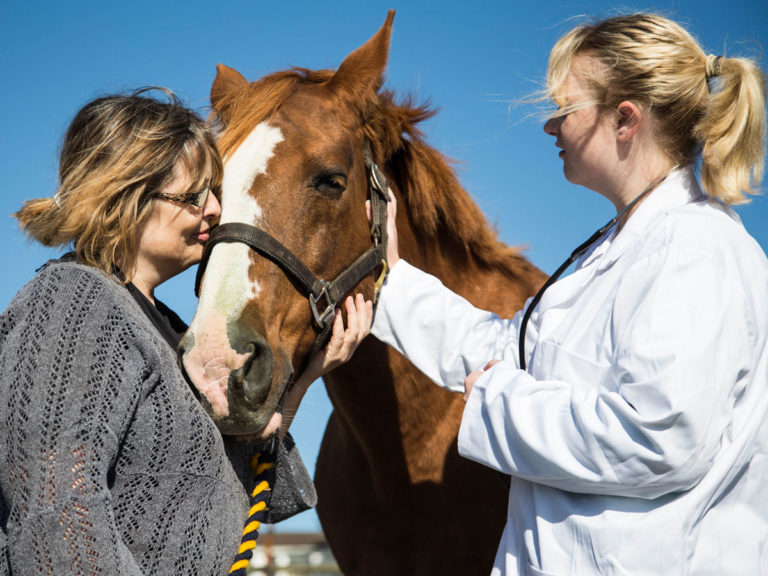
While the exact mechanism for triggering equine recurrent uveitis (ERU) is not completely known, the breakdown of the blood-ocular barrier elicits immune responses in the eye. In horses affected by ERU, the normal regulatory pathways and immunosuppressive actions and immune tolerance are less effective, leading to chronic equine recurrent uveitis.
ERU is potentially triggered by a variety of factors. Some are genetic and breed-specific, some are auto-immune responses, and others are due to infectious disease. A study investigated the various risk factors for ERU and designated them into specific categories [Kingsley, NB.; Sandmeyer, L.; Bellone, RR. A review of investigated risk factors for developing equine recurrent uveitis. Veterinary Ophthalmology 2023, vol 26; pp. 86 -100; doi: 10.1111/vop.13002].
When faced with cases of equine recurrent uveitis, there are a number of potential differential diagnoses to consider.
Environmental and Infectious Risk Factors
Leptospira interrogans
A causal relationship between Leptospira and ERU was documented in 1971, identifying a latency period of 1-2 years between infection and onset of ocular inflammation. The spirochetes are able to cross the blood-ocular barrier to reach the immune system. Biofilm formation within the vitreous humor may pose an obstacle to treatment and may also interfere with detection methods. Other studies have contradicted the supposition that Leptospira is an environmental risk factor. However, the general assessment is that “infection with the spirochete bacterium is sufficient for ERU to develop but may not be required to initiate disease in all horses.” Leptospira might act as a trigger and contribute to disease severity.
Rhodococcus equi
Besides respiratory infection, R. equi also creates ocular effects such as uveitis. One study that spanned more than 20 years in the southwestern USA confirmed uveitis in 11% of 150 foals infected with R. equi. Survival rate of these foals was around 19%, and of those, all retained their vision. Further data regarding long-term impacts like ERU are not available.
Borrelia burgdorferi
Lyme disease is associated with injury to many organ systems, including the eyes. In horses, Lyme-associated uveitis is not common. Those with Borellia-associated uveitis tend to display other clinical signs such as neurologic deficits, lameness, arthritis and muscle wasting.
Parasitic infiltration
Infiltration of ocular structures by parasites is a rare trigger for ocular inflammation. Onchocerca cervicalis is one species with a definitive link to uveitis. Other possible but rare triggers include Setaria or Halicephalobus spp. Treatment readily resolves all three of these parasites as ERU triggers.
Viruses
Equine arteritis virus (EAV), equine influenza and equine herpesvirus (especially EHV-1) have been linked to ocular disease. Influenza and EAV can trigger conjunctivitis, periocular edema and lacrimation, whereas EHV is reported to trigger uveitis. Horses experimentally infected with EHV, but without equine herpes myeloencephalopathy (EHM), developed choroidal retinitis within three months following infection. Currently, there is no confirmation that viral infection is a risk factor for ERU.
Non-Infectious Risk Factors
Increased Age
The average age of ERU recognition is 11.6 – 12.3 years, although the age of onset might be earlier than diagnosis. A study of 1,014 horses of 40 breeds identified ERU in 25-30% of horses over the age of 15 years.
Gender
There are no studies that support a link between gender and ERU, although more investigation is necessary to look at sex-specific hormones or sex-linked genes.
Management Factors
To date, dysbiosis of the microbiome has not been linked to ERU, but more investigations are needed to look into diet, obesity, activity level and microbiome composition.
Vaccinations
To date, a few studies have not linked vaccinations, including for Leptospirosis, with progression or recurrence of ERU.
Habitat Influences
Turnout on flooded pasture and proximity to a pig farm were identified in a study as risk factors for a primary occurrence of uveitis.
Genetic Risk Factors
Breed
A higher incidence of ERU is known to occur in German Warmbloods, Icelandic horses, and Appaloosas (and horses with similar coat spotting patterns, such as the Knabstrupper and Pony of the Americas) than in other breeds. The incidence of ERU in Appaloosas is reported as 25%.
Leopard complex spotting (LP) in Appaloosas and Knabstrupper breeds is a specific phenotype of a white pattern centered over the hips that varies in extent, including from minimal to an entirely unpigmented coat. Horses with a larger amount of white patterning at birth seem to be at the greatest risk for ERU. These horses have an 8.2-65.8% greater chance of developing insidious ERU than horses without this spotting pattern. Not all horses with LP develop uveitis. However, nearly 41% of horses with LP coats experience insidious uveitis. The authors suggest that “additional genetic loci are involved in development of insidious uveitis” besides the LP locus.
Genetic studies have identified specific major histocompatibility complex (MHC)—immune genes primarily involved in antibody formation—and other genomic and allele variables that could have links to ERU. At this time, more studies are ongoing to determine what, if any, specific genetic markers and factors are linked to ERU in high-risk breeds.








